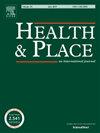Effects of urban greenspace on time to major adverse cardiovascular events among women with breast cancer in the US: Insights from the Greater Milwaukee, WI Area
IF 4.1
2区 医学
Q1 PUBLIC, ENVIRONMENTAL & OCCUPATIONAL HEALTH
引用次数: 0
Abstract
Background
Cardiovascular (CV) disease (CVD) remains a significant concern among breast cancer (BC) survivors, particularly following potentially cardiotoxic treatments, such as anthracyclines and anti-HER2 drugs, which increase the risk of major adverse CV events (MACE). Social determinants of health (SDOH) and environmental factors influence health outcomes, including those related to CVD. Urban greenspace has been associated with CV and cancer-related health benefits, yet its specific impact on MACE among BC survivors remains unknown.
Objective
This study aims to investigate the association between urban greenspace and time to first MACE incidence among individuals with BC after being treated with cardiotoxic therapies in the greater Milwaukee, WI area.
Methods
A retrospective cohort study was conducted using electronic medical records from the Froedtert Health System, linked to the National Death Index. Cox proportional hazards regression models were used to assess the association between percent tree canopy cover and MACE-specific hazards, adjusting for sociodemographic, clinical, and neighborhood-level factors.
Results
Among the 849 women included, 44.6 % experienced a MACE. Adjusted models indicated an 18 % reduction in MACE-specific hazard (HR: 0.82, 95 % CI: 0.70, 0.96) and a 20 % reduction in MACE-specific hazard (HR: 0.80, 95 % CI: 0.67, 0.97) for women in the second and third quartiles of percent tree canopy cover, respectively, compared to the women in the first (lowest) quartile. However, we did not observe a risk difference for women living in the fourth quartile of tree canopy. Racial/ethnic disparities in greenspace exposure and MACE incidence were evident, with Non-Hispanic Black (NHB) women having a lower proportion living in areas with the highest tree canopy cover and a higher MACE incidence (61.9 %) compared to Non-Hispanic White (NHW) women (41.6 %), who had the highest proportion residing in areas within the 4th quartile of tree canopy cover.
Discussion
Our findings suggest that urban tree canopy is associated with time to incident MACE among BC survivors receiving cardiotoxic treatments. These results underscore the importance of considering socioenvironmental factors in CardioOncology care and highlight the benefits of greenspace in mitigating CV complications among individuals with BC. Future research should delve into individual lifestyle and behavioral factors, environmental factors, and biological mechanisms that may underlie these associations. Additionally, longitudinal studies should be conducted to evaluate greenspace-based interventions for BC survivors, aiming to advance precision CardioOncology interventions. Observed racial/ethnic disparities in MACE incidence underscore the urgent need for equity-focused interventions addressing greenspace access and MACE-related disparities.
城市绿地对美国女性乳腺癌患者主要不良心血管事件的时间影响:来自威斯康星州密尔沃基地区的见解
背景:心血管(CV)疾病(CVD)仍然是乳腺癌(BC)幸存者的一个重要问题,特别是在潜在的心脏毒性治疗之后,如蒽环类药物和抗her2药物,它们增加了主要不良CV事件(MACE)的风险。健康的社会决定因素(SDOH)和环境因素影响健康结果,包括与心血管疾病相关的结果。城市绿地与CV和癌症相关的健康益处有关,但其对BC幸存者MACE的具体影响尚不清楚。目的:本研究旨在调查在威斯康星州密尔沃基地区接受心脏毒性治疗的BC患者中,城市绿地与时间与首次MACE发病率之间的关系。方法:回顾性队列研究使用Froedtert卫生系统的电子医疗记录,并与国家死亡指数相关联。Cox比例风险回归模型用于评估树冠覆盖率百分比与mace特异性风险之间的关系,并对社会人口统计学、临床和社区水平因素进行了调整。结果:纳入的849名女性中,44.6%经历过MACE。调整后的模型显示,与第一个(最低)四分位数的女性相比,第二和第三个四分位数的女性mace特异性风险分别降低了18% (HR: 0.82, 95% CI: 0.70, 0.96)和20% (HR: 0.80, 95% CI: 0.67, 0.97)。然而,我们没有观察到居住在树冠的第四个四分位数的女性的风险差异。绿地暴露和MACE发病率的种族/民族差异是明显的,非西班牙裔黑人(NHB)妇女生活在最高树冠覆盖率地区的比例较低,MACE发病率(61.9%)高于非西班牙裔白人(NHW)妇女(41.6%),后者居住在树冠覆盖率的第四个四分位数内的比例最高。讨论:我们的研究结果表明,城市树冠与接受心脏毒性治疗的BC幸存者发生MACE的时间有关。这些结果强调了在心血管肿瘤治疗中考虑社会环境因素的重要性,并强调了绿地在减轻BC患者心血管并发症方面的益处。未来的研究应该深入研究个人的生活方式和行为因素、环境因素以及可能导致这些关联的生物学机制。此外,应该进行纵向研究来评估基于绿色空间的BC幸存者干预措施,旨在推进精确的心脏肿瘤学干预措施。观察到的MACE发病率的种族/民族差异强调了迫切需要以公平为重点的干预措施来解决绿色空间准入和MACE相关的差异。
本文章由计算机程序翻译,如有差异,请以英文原文为准。
求助全文
约1分钟内获得全文
求助全文
来源期刊

Health & Place
PUBLIC, ENVIRONMENTAL & OCCUPATIONAL HEALTH-
CiteScore
7.70
自引率
6.20%
发文量
176
审稿时长
29 days
期刊介绍:
he journal is an interdisciplinary journal dedicated to the study of all aspects of health and health care in which place or location matters.
 求助内容:
求助内容: 应助结果提醒方式:
应助结果提醒方式:


